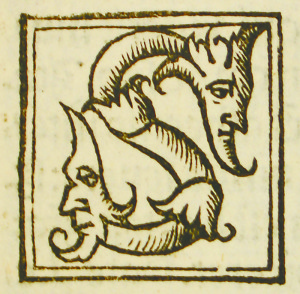By Barb Arland-Fye
The Catholic Messenger
DAVENPORT — Writing in the margins of textbooks is as old as, well, the printing press. But reading “marginalia” penned through the centuries in a 500-year-old text book offers an ongoing source of fascination for scholars of St. Ambrose of Milan.
St. Ambrose University’s Academy for the Study of St. Ambrose of Milan has acquired a manuscript of the fourth-century doctor of the Church that was published Dec. 4, 1514. A student of Ethan Gannaway, the academy’s executive coordinator, found the historic book on eBay and correctly assumed the academy would be interested in it.

This is the letter “S” as it appears in a 500-year-old book containing a manuscript of the 4th century St. Ambrose of Milan. St. Ambrose University in Davenport acquired the book for the Academy for the Study of St. Ambrose of Milan.
Father Bud Grant, the academy’s director, says the book is a treatise on Christian virtue with specific emphasis for the elite, cultured Roman clergy and probably laity.
Intrigued with the study notes that students of the text had written in the book’s margin, Fr. Grant invited a Milan-based archivist and palaeographer (one who studies ancient and historical handwriting) to share his findings with a St. Ambrose University audience.
Brian Berni gave his presentation Dec. 7 on the feast of Saint Ambrose. Based on his educated guess, the book originally belonged to a Franciscan monastery where seminarians likely studied it + and marked the margins with notes written in Latin.
Much like modern students, the readers of this text tended to sum up or paraphrase the content in their margin notes. At least three or four different writers penned their thoughts in the margins, Berni surmises.
In addition to Berni’s keynote address, several St. Ambrose University faculty members shared observations of the book from their areas of expertise.
Fr. Grant, a moral theologian, noted that the Christian classics were very popular at the time of the book’s printing because they lacked any taint of paganism. Saint Ambrose had recently been declared a doctor of the Church. Christian humanist Erasmus and many other theologians of that era were interested in restoring the theological perspectives of Ambrose and other Patristics (or fathers of the Church). Protestants were also coming to appreciate the Patristics as a more authentic source of theology. Furthermore, the reform of the clergy was a huge goal for the Council of Trent (about 40 years after the book was published). The book was a perfect way to achieve that, Fr. Grant added.
Joseph Lappie, assistant professor in the art department, observed that the book was printed at a time when the printing press was gaining enormous interest in the world, much as the Internet has absorbed today’s audiences. Intended for a specific audience, the book would have been passed along within a school or library where many people likely had access to it. The book was made of paper, not the more expensive vellum, he added.
Beth Shoemaker, catalog and resource access librarian, noted: “this is essentially a library book; you don’t highlight a library book today, but everybody was doing it then.” Because bookmaking was a laborious process and each letter was set by hand, people had no qualms about fixing mistakes, she said. This book “wasn’t a deluxe edition; it was meant to be used.”
Theology professor Corinne Winter said hand-written material at the end of the book contained what might be described as a rough draft for a lecture on perhaps the Trinity in the early 16th century.“Ambrose didn’t have a history of writing about the Trinity,” she added. So it was puzzling to her that the anonymous writer chose to write about the topic in St. Ambrose’s book.
The book requires some “TLC” restoration from the university’s archivist; then it will be displayed in the Academy for the Study of St. Ambrose of Milan office in the university’s library, Fr. Grant said.








